Physical Address
304 North Cardinal St.
Dorchester Center, MA 02124
Several factors play a role in the evaluation of the cellular sample. The method of sample collection and fixation, the laboratory procedure to process the sample, and the integration of the morphologic features observed in the sample with the clinical information may affect the quality of interpretation/diagnosis reached.
The ultimate goal in specimen processing is to preserve, as much as possible, in vitro or in vivo aspects of the sample obtained. This includes the original size, shape, and texture of the cytoplasmic and nuclear components present. Among the desired results of a well-preserved cellular specimen is the ability to accurately assess quantitative and semiquantitative criteria, including hyperchromasia, nuclear/cytoplasmic ratio, and chromatin patterns. The recognition of fine nuclear details such as grooves, notches, inclusions, and pseudo-inclusions is essential for the definitive diagnosis of certain subtypes of thyroid, breast, urinary, and soft-tissue tumors with concomitant prognostic implications. Equally important is maximizing the number of true tissue fragments. In contrast to the screening nature of the Papanicolaou (Pap) test, where an interpretation of the sample is followed by a biopsy to establish the final diagnosis, fine-needle aspiration (FNA) is used to obtain a definitive diagnosis and as more targeted therapies are developed, expectations on the diagnostic performance of cytopathologists will increase.
The three major processing modalities for non-gynecologic specimens consist of direct smear , filtration (Millipore, SurePath, ThinPrep, and LiquiPrep) and cytocentrifugation-based preparations (Cytospin). All three techniques share the capacity to archive a portion of the specimen for the application of special and immunocytochemical stains. Each modality subjects the cellular material to different degrees of physical forces and chemical influences. This will result in certain artifact profiles that can affect cytomorphologic interpretation. True tissue fragments with architectural features similar to those of histologic specimens are present in quality direct smears ( Fig. 5-1 ). The preservation of diagnostically important true tissue fragments and the 3-dimensional microtopography of the Millipore cellulose filter produce an increased depth of field and subsequent exquisite cytologic detail ( Fig. 5-2 ). The ThinPrep technique consistently produces the truest monolayer, thus minimizing the obscuring effects of background elements and cellular clumping ( Fig. 5-3 ). SurePath and Cytospin preparations also present excellent cytomorphology ( Figs 5-4 , 5-5 ).
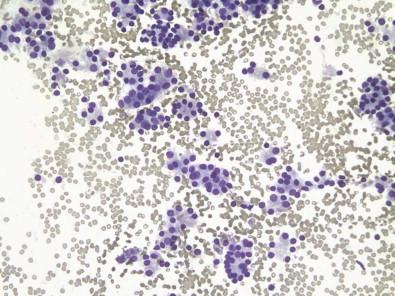
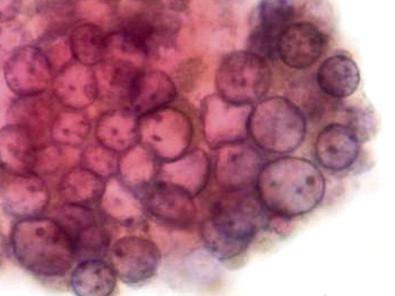
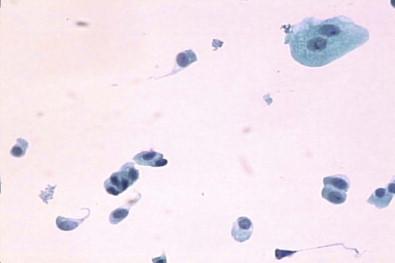
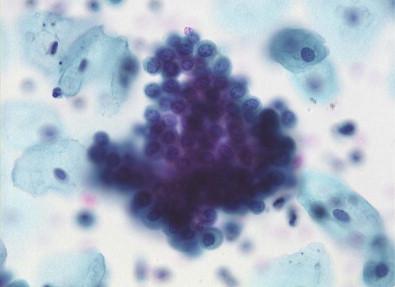
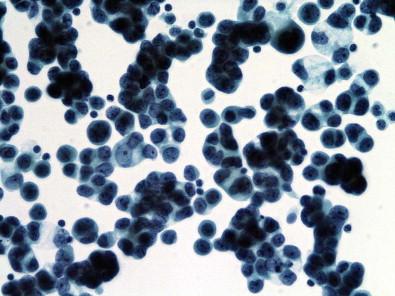
When sufficient cellularity and technical support are available, cell blocks can provide much in the way of additional diagnostic information. Included among the possibilities are architectural and staining properties that approach what is seen in conventional paraffin-embedded hematoxylin and eosin (H&E)-stained surgical biopsies . In this manner, cell blocks often provide an immeasurable level of comfort to many pathologists more accustomed to conventional histologic diagnoses. In particular types of FNA specimens, such as salivary gland cystic lesions, thyroid nodules, and liver and pancreatic lesions, conventionally prepared cell blocks may provide key information to clinch a definitive diagnosis . A common example is in distinguishing chronic sialadenitis from Warthin's tumor, in which characteristic large papillary oncocytic lymphoepithelial tissue fragments are best appreciated and often only appear in the cell block pellet derived from needle rinses ( Fig. 5-6 ). Similarly, cell blocks have been reported to be extremely helpful in discerning malignant papillary tissue fragments containing fibrovascular cores from benign papillary tissue fragments that for the most part lack fibrovascular cores. Also the characteristic Orphan Annie-eyed nuclear chromatin pattern (felt by some to be a useful reproducible histologic artifact) is best seen in cytology specimens that have been conventionally processed into formalin-fixed paraffin-embedded cell blocks.
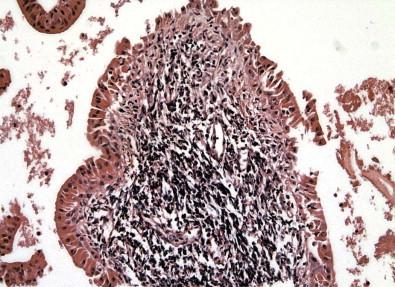
The following paragraphs document the fact that immunocytochemistry can be performed successfully on Cytospin, ThinPrep, Millipore filter, and direct smear slides. Options are somewhat limited in terms of the number and types of antibodies available due to the typically sparse and delicate nature of the cellular material present in these preparations. Many articles, on the other hand, describe the diagnostic usefulness of a variety of immunohistochemical stains on cell block material. In particular, paraffin-embedded cell blocks have proven efficacious by helping to resolve benign reactive lesions from both primary and metastatic tumors ( Fig. 5-7 ). Such common dilemmas may often require a panel of immunohistochemical stains. (See Chapter 36 for additional information.)
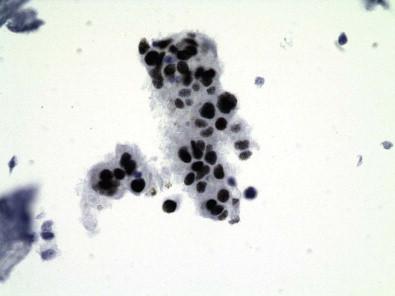
There are many articles found in the contemporary literature which compare the efficacy of the processing modalities based on costs, cellular yield, unsatisfactory rates, artifacts, and diagnostic accuracy. Most deal with specific types of specimens such as urine, pleural fluid, pancreatic/biliary tract, soft tissue, breast, and thyroid FNA. The recommendations of the various authors differ somewhat in favoring one processing technique over the other. A thorough review of the relevant literature, however, leads one to the conclusion that direct smears, cytocentrifugation, and filtration techniques are worthy of routine use with comparable diagnostic and cost parameters for most non-gynecologic specimens. In the end, the decision to utilize one or more of the processing techniques depends upon weighing the service demands against the financial and labor resources available in a particular laboratory.
The following highlights some observations in the literature concerning these processing modalities.
Cellular yield was found to be superior by the ThinPrep method, which retained three times as many cells as cytocentrifugation. There were no statistically significant differences in unsatisfactory rates, sensitivity, specificity, or positive predictive value in both FNA and body cavity fluid specimens processed by ThinPrep and direct smears methods. Luu and colleagues reported combining smears, and ThinPrep increases the rate of definitive diagnosis in papillary thyroid carcinoma. Overall technical quality was reported to be improved by ThinPrep processing when compared with direct smears on split FNA specimens due to cleaner background and better monolayer formation. Some authors, however, advised caution to avoid diagnostic errors when interpreting ThinPrep slides due to the increased incidence of the following cytologic artifacts ( Table 5-1 ): disruption of tissue fragments, formation of cell clusters, aggregation of lymphocytes, cellular shrinkage, attenuation of nuclear details, and exaggeration of nucleolar prominence. In comparison with SurePath processed specimens, ThinPrep slides demonstrated increased cellular shrinkage, flattening, and fragmentation of large cellular sheets and nuclear chromatin patterns were reportedly more difficult to evaluate. SurePath slides were also found to contain larger branched 3-dimensional tissue fragments.
| Cellularity | Nuclear | Background |
|---|---|---|
| Cellular shrinkage | Increased naked nuclei | Loss of adipose tissue, stroma, mucin, and colloid |
| Disruption of tissue fragments | Decreased nuclear chromatin details | Colloid that appears as dense droplets |
| Flattening and fragmentation of large cellular sheets | Attenuation of nuclear grooves and pseudo-inclusions | Aggregation of lymphocytes |
| Formation of cell clusters | Exaggerated nucleolar prominence | |
| Artificially increased single epithelial cells |
Become a Clinical Tree membership for Full access and enjoy Unlimited articles
If you are a member. Log in here